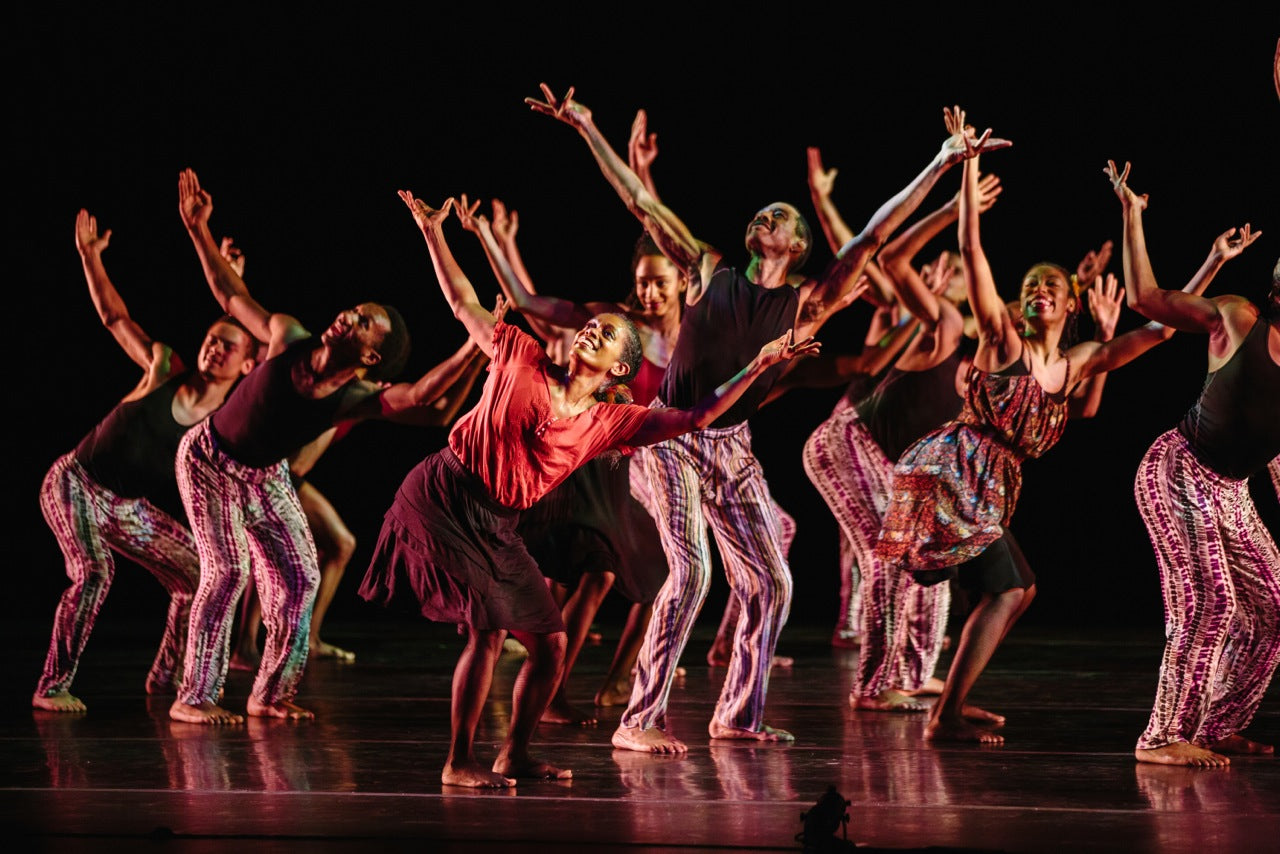But, then again, this is no ordinary dance company. Founded in Rochester, NY, in 1970 by Fagan, who went on to win Tony and Olivier awards for his choreography for 1997’s “The Lion King” (directed by Julie Taymor, that smash hit has become the most successful work of entertainment in history), the troupe delivered a knockout punch with each and every number.
Of particular interest was Fagan’s 2015 piece, “Geoffrey Holder Life Fete…Bacchanal,” a West Coast premiere and tribute to Fagan’s longtime friend and fellow artist—dancer, choreographer, painter, designer and actor—who died in 2014 at 84. Set to Robert Greenidge’s upbeat, steel-pan infused score, the work is bookended with groups of ebullient, hip-swaying women, their beaming faces a celebratory invitation, and equally high-spirited men, the unisons a rhythmic conga line of unmitigated glee.
Jiggy to the max, the dancers were clad in bright, beachy skirts, tops and printed drawstring pants (this reviewer felt like reaching for her SPF 50). They skittered, pirouetted and raised their arms, as if beckoning the very soul of Holder, who had been born in Trinidad, with Jamaican-born Fagan capturing the Caribbean’s essence with both ease and finesse.
Segueing from party-time limboing to the passionate relationship between Holder and his wife, dance superstar, Carmen de Lavallade, Norwood Pennewell and Adriene Barber were perfectly cast as the couple that had been married for 59 years. A tall, lean Pennewell, who at 57 is still able to summon rock-solid balances and mercurial turns, could be a Giacometti sculpture come to life. He held Barber tenderly, as a voice-over, recorded by Fagan, now 75, and culled from a remembrance written by Leo Holder, the couple’s son, provided a poignant testament to a life well lived—and loved.
While the narration recalled Holder’s noble gestures from his hospital bed in the ICU, dancers moved ardently around the pair. Beautiful creatures acknowledging a master, these performers embodied the vitality and huge talent that was Holder, with Lutin Tanner’s lighting design providing warmth as well as a kind of ghostly fervor.
When Barber wrapped her legs around Pennewell, a rush of grief could be felt, this melancholy then morphing into solace as Pennewell lifted and spun her around with, well, controlled abandon.
The profound words, “He died while he was fully alive,” proved an apt encomium, Fagan’s dance carrying Holder’s legacy ever forward.
It was also a brilliant night for Pennewell, choreographically, with the West Coast premiere of his 2015 work, “So You See.” A company member for an inconceivable—but true—38 years, the Bessie Award-winning dancer, also Fagan’s muse/assistant and rehearsal director, set the piece to a jazzy score by Marc Carey and Vijay Iyer.
A series of duets, trios and a solo, all featuring the astonishing Sade Bully, whose 6 o’clock extensions and long-held, quarter-turn arabesques are gasp-worthy, the work, abetted by the company, is, in fact, estrogen-driven.
And that’s a good thing, as the women, including another Bessie Award winner, Natalie Rogers, 54 and also a longtime troupe member, director of Fagan’s dance school and assistant rehearsal director, thrilled with a lush trio, joined by Barber and Bully. The sinewy entwinings of the latter two, with their glorious arching backbend, made manifest the word, ‘trust.’
Bully, able to move from stasis to huge leaps, also performed with Pennewell in an excerpt from Fagan’s 1991, “Griot New York.” (In West African tribal cultures, a griot refers to someone who preserves and transmits people’s history and traditions in song, dance and verse.)
Set to Wynton Marsalis’s commissioned score—here a piano and trumpet—this segment, “Spring Yaounde,” also featured Martin Puryear’s whimsical sculpture, a huge agricultural tool shaped like a hoe, as backdrop to a languorous, achingly slow and erotic pas de deux, the extended lyricism adding to the mesmeric quality of the dance.
Completing the program were three other works, also containing the wow factor. Almost a ‘greatest hits’ cavalcade—though there are too many Fagan masterpieces for just one evening—the program opened with Fagan’s “Prelude: Discipline is Freedom,” from 1981 (and revised two years later). A polyrhythmic feast teeming with jagged moves that presaged “The Lion King”—cross-stage patterns, buoyant, gravity-defying leaps and barrel turns, “Prelude” boasts an original company member, Steve Humphrey.
At 64 and sporting a grey topknot, rock-hard abs and an engaging smile, Humphrey is an ebullient mover, demonstrating that this Bessie awardee still has the goods, and in the process, is, decidedly, an inspiration.
With “Passion Distanced,” from 1987 and set to Arvo Pärt’s “Fratres”—before the Estonian Holy Minimalist composer became overexposed—Fagan set the tone for the Holder work, the elegiac, but churning, violin and piano a perfect accompaniment to the sometimes nervous moves and quirky poses assumed by Pennewell, Barber and Bully, as well as dancers Guy Thorne, Wynton Rice and Sarah Herbert.
The concert ended with the appropriately titled, “Come…Celebrate,” an excerpt from Woza (Zulu for “come”), made in 1999. With South African composer Lebo M’s score, the work is a rollicking marriage of movement and music, the company enlivening the stage with the Fagan brand of rapture, revelry and revelation; indeed, an awesome display of all that is good in the world.
Wouldn’t it be wonderful, then, if Garth Fagan Dance could make its West Coast home at the beautiful Nate Holden Performing Arts Center? This dance scribe—and many Angelenos—would surely be down with that.




comments